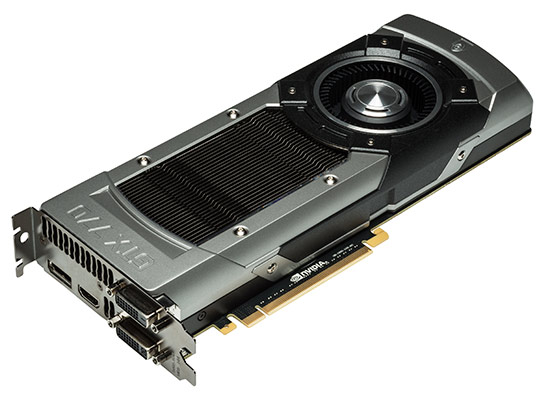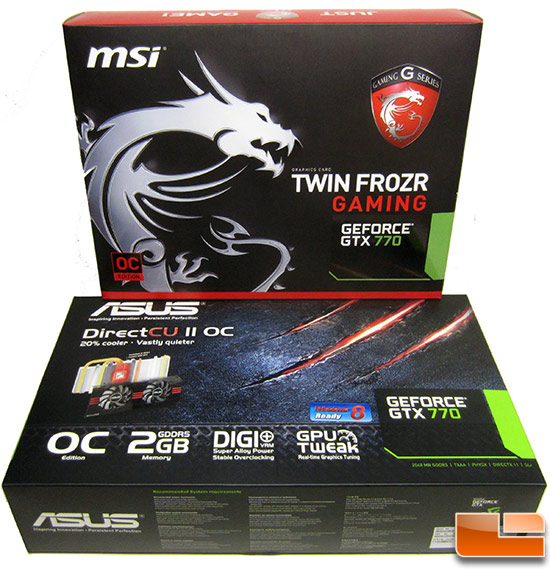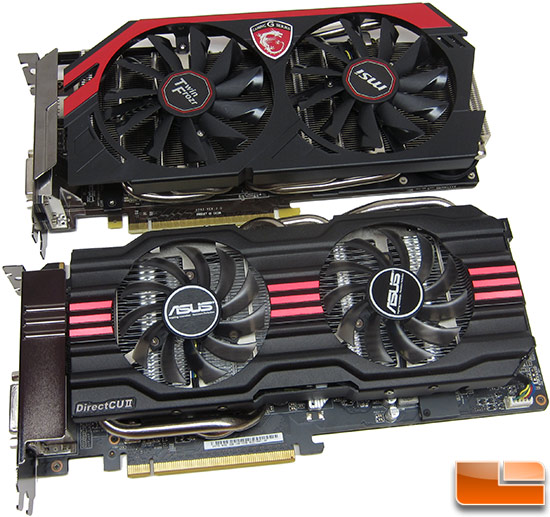MSI GeForce GTX 770 Gaming and ASUS GeForce GTX 770 DirectCU II Review
NVIDIA GeForce GTX 770 – GTX 680 Refreshed
Last week NVIDIA introduced the GeForce GTX 780, which became the company’s first GeForce 700 series graphics card to be released! Quickly following the release of that card comes the NVIDIA GeForce GTX 770. This card is similar to a GeForce GTX 680, but has been refreshed with a new GPU cooler, more powerful power system, higher clock speeds, 7Gbps memory modules, and GPU Boost 2.0 technology. GPU Boost 2.0 technology basically means that the cooler the GPU operates, the faster it performs. Boost 2.0 also gives you more control over the GPU, so you can do overvoltaging. The best thing about this overhaul of the GeForce GTX 680 is that the new GeForce GTX 770 is priced at $399 for the 2GB version and a 4GB version should be coming out later in June for around $448 ($49 more than 2GB card).

If you take a look at the image above you’ll see that the NVIDIA GeForce GTX 770 reference card looks nearly identical to the GeForce GTX Titan/780 as it shares a similar GPU Cooler. The GeForce GTX 770 reference board measures 10.5” in length. Display outputs include two dual-link DVIs, one HDMI and one DisplayPort connector. One 8-pin PCIe power connector and one 6-pin PCIe power connector are required for operation.
| GTX 780 | GTX 770 | GTX 680 | |
| GPU | GK110 | GK104 | GK104 |
| Streaming Multiprocessors | 12 | 8 | 8 |
| Stream Processors | 2304 | 1536 | 1536 |
| Texture Units | 192 | 128 | 128 |
| ROPs | 48 | 32 | 32 |
| Core Clock | 863MHz | 1049MHz | 1006MHz |
| Boost Clock | 902MHz | 1085MHz | 1058MHz |
| Memory Amount | 3072MB GDDR5 | 2048MB GDDR5 | 2048MB GDDR5 |
| Memory Clock | 6008MMHz | 7010MHz | 6008Hz |
| Memory Bus Width | 384-bit | 256-bit | 256-bit |
| Memory Bandwidth | 288.4 GB/s | 224.3 GB/s | 192.26 GB/s |
| TDP | 250W | 230W | 195W |
| Suggested Power Supply | 600W | 600W | 550W |
| Transistor Count | 7.1B | 3.54B | 3.54B |
| Manufacturing Process | TSMC 28nm | TSMC 28nm | TSMC 28nm |
| Street Price |
$649 | $399 | $449 |
When it comes to the NVIDIA GeForce GTX 770 specifications you’ll be happy to learn that the reference card has a base clock of 1049MHz and a Boost click of 1085MHz, which is a ~2.5% bump in boost performance. Both cards share the GK104 Kepler GPU, so the stream processors (CUDA Cores) remain the same at 1536. The GeForce GTX 770 and GeForce GTX 680 both have 128 texture units, 32 ROPs and a 512KB L2 cache size.
The one major difference that we need to talk about on this card is on the GDDR5 memory. In recent months 7Gbps memory has been made available by Hynix and Samsung, and NVIDIA moved to it for this refresh. In order to do that NVIDIA found that they had to beef up the board power. NVIDIA went with a 4-phase power design for the GPU and a 2-phase power design for the 2GB of GDDR5 memory on the GeForce GTX 680 reference card. The new GeForce GTC 770 reference card has the same GPU power system, but stepped up to a 3-phase power design for the more power hungry 7Gbps memory chips. This is why someone can’t just flash an old GeForce GTX 680 and make it GeForce GTX 770 as it actually requires more power. This is the main reason why the boards TDP went from 195W on the GTX 680 to 230W TDP on the GeForce GTX 770. So, thanks to these new GDDR5 IC’s and the boards beefed up power system, NVIDIA is able to get 7010MHz (effective) memory running on the 256-bit memory interface. This ~1Ghz jump in memory clock means that the memory bandwidth on the GTX 770 is now 224.3 GB/s, which is a 17% increase. So, the GeForce GTX 770 has higher clock speeds, beefed up power and should run cooler (run in boost longer).

NVIDIA unfortunately did not send Legit Reviews a GeForce GTX 770 reference card, so we do not have one to show you or use today as a baseline card in the performance tests. The good news is that our friends over at ASUS and MSI came to the rescue and provided us with their custom GeForce GTX 770 solutions that both come overclocked from the factory.

Neither ASUS or MSI will have a GeForce GTX 770 video card based off the reference design or with reference clock speeds. So, we will be looking at the ASUS GeForce GTX 770 Direct CU II OC 2GB and the MSI GeForce GTX 770 Twin Frozr Gaming OC 2GB. Both cards have a suggested retail price (SRP) of $409.99.
Now that we have the basics covered, let’s take a quick look at the test setup and move along to the game benchmarks!

Comments are closed.